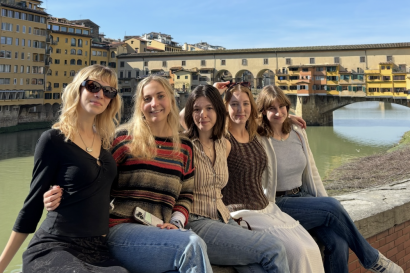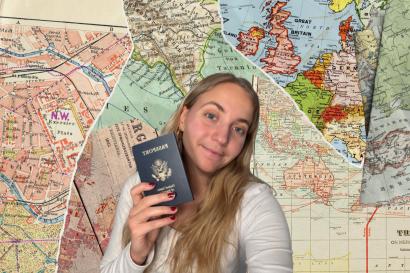
I’d like to tell you all a story with a sad start, but a happy ending - all about running.
When I was eighteen years old, I was a hard-working high school student as well as an aspiring actress, singer, and dancer. I was stressed out over college applications and upcoming auditions. I was always on the move, but I could barely run farther than the one mile required for our school’s annual fitness test.
Later that same year, my mom passed away from cancer. My world came to a crashing halt. Everything in my life that once was constant, broke into a thousand pieces. I was still in the midst of senior year chaos, although none of my old priorities seemed to matter anymore. And I now had to face my mounting academic and extracurricular obligations without the help of my best friend.
In the difficult months following my mom’s passing, I made some crucial decisions about where to pull back and where to refocus my energy. With the support of many family members and friends, I chose a university that allowed me to pursue all my passions and interests. But I still felt a need to make a drastic change to my daily routine - something that would provide me with a new sense of purpose in an unsteady chapter.
That’s when I started running. Although I had dreaded the act in the past, I made a conscious decision that I would learn to enjoy it. I embraced it as a chance to add consistency back to my life, to tackle the eating disorder I had developed during my mother’s illness, and to prove to myself that I was capable of accomplishing something I had once thought impossible. After a few months of following a couch to 10k plan, I was easily running distances of 4 to 6 miles almost every morning. I grew to love the feeling of waking up early and hitting the road, and arriving to class already feeling accomplished for the day.
Flash forward two years, I was still a regular runner. I had run my way through two years at the University of Richmond, two summers in Sevilla, and five weeks in Morocco. I had improved my body image. I also learned how to properly fuel my body and adhere to proper rest. I made countless friendships through running, and explored numerous cities through a unique perspective.
When I arrived in Granada the fall of my junior year, I quickly befriended a fellow runner named Margo. She was also studying with IES Abroad Granada for the full year. We agreed to only speak to each other in Spanish, and together we set off over our first few days to explore some of the city’s running trails.
It turns out Granada is a fantastic and scenic (albeit hilly) city to run in. Our favorite trails became the flat, smooth path along the Rio Genil, and the path that winds past the Alhambra and up through the surrounding mountains, dotted with olive groves.
By mid-September, I was happily adjusted to my normal, running routine. That’s when Margo asked me if I would run the EDP Women’s Half Marathon with her in Madrid. She was in the midst of training for the full marathon in Malaga, while I had never run more than six miles in my life. The notion of tackling 13.1 miles was daunting. But her motivation inspired me to try something completely out of my comfort zone.
Over the next month, I made the shift to endurance running. I ran longer distances and took more rest days. I invested in new shoes and gear, and started reading several running blogs. I learned several useful skills, including, how to smoothly open and consume an energy gel midway through a long run, and how to not lose all my toenails.
When race day rolled around, I was proud of myself for just showing up for an event I never thought I would pursue. I set one goal - to finish - with a secondary goal of finishing in under two hours. The race set off through the beautiful, downtown streets of Madrid. Halfway through, I realized I was making very good time, running a full minute under my average pace. Eleven miles into the course, I began to fall back. That's when the woman who had been running beside me the whole race shouted, “Venga rubia!” (Come on, blondie!)
That was the last bit of motivation I needed.
I completed the course in just under 1 hour and 40 minutes, placing in the top 5% of finishers. Margo and I both finished well under our time goals, and we enjoyed a long day of eating our way through Madrid to celebrate.

[[{"fid":"647826","view_mode":"loop","fields":{"format":"loop","alignment":""},"link_text":null,"type":"media","field_deltas":{"2":{"format":"loop","alignment":""}},"attributes":{"class":"media-element file-loop","data-delta":"2"}}]]
I will always regard the experience of running my first half marathon as one of my favorite memories from Spain. It was a huge, personal accomplishment that I was lucky to share with one of my best friends.
And as of this past Saturday, I can happily report that I completed my second half marathon right here in Granada. While the course was extremely hilly and chalenging, it was also incredibly beautiful. And it was a powerful experience to run a race in the city I now call home.

I now proudly identify as an endurance runner. I love not only the feeling long distance running gives me (runner’s high is a thing), but I also view it as a powerful metaphor for study abroad, and for life in general.
In long distance running, you have to push through every, last mile. When you can convince yourself to go that much farther, to take one more step, that’s when you truly grow and improve.
Apply that same philosophy to study abroad, and you also find that real growth happens only and immediately after you step out of your comfort zone. For most study abroad students, that first big step is getting on the plane and deciding to take the journey. Just as my first big step as a runner was choosing to run in the first place.
But as I’ve stated in previous posts, we are naturally creatures of routine. When confronted with a completely unfamiliar environment, we look for constants to cling to. These could be regular paths to class, familiar foods, or our English-speaking friends.
But just as in long distance running, you only get a certain number of points for showing up. The rest is really up to you. It’s your experience at the end of the day - your marathon. And I guarantee that the feeling of trying something new, of potentially looking goofy, or stupid, or failing all together, always outweighs the feeling of regret.
I’m not always great at following this advice myself, especially as everything here in Granada feels so familiar to me now. But I find myself feeling happier and more fulfilled on the days when I try a new dance class, attend an language exchange, or simply strike up a conversation with the person next to me in my university class. Some of these moments become fun stories to tell, but other times they develop into strong friendships or new passions.
I don’t see myself giving up running anytime soon (I am already investigating running clubs in Cuenca, Ecuador, where I will be this summer). But I will switch things up in my last month here by going back to cycling class at the gym and maybe finally trying that morning yoga class I’ve been eyeing.
These changes will be easy. Harder yet will be encouraging myself to reach out more in my university classes, my residence hall, and to nurture budding relationships I’ve started here so that they might grow into lasting connections.
Making a small change in your routine can often seem untimely or unfeasible, but speaking as a runner, you always have one mile left in you. Once you convince your mind to keep going, your feet will follow.

Emily Churchill
<p>Hola caracolas! My name is Emily and I'm studying abroad in Granada, Spain for the 2017-2018 academic year. I'm a Spanish and International Studies major who is always looking for new ways to connect with my beautiful host city. I love to sing, play guitar, act, and have embarked on the journey of writing a historical fiction novel about Granada! In my free time, I love to run and hike in the Sierra Nevada mountains, get lost in the Albaicin, and explore new cafes and tapas bars with my friends. This semester I hope to try my hand at Flamenco guitar, take more siestas, and make even deeper connections with the city and its people.</p>







